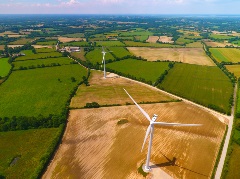Introduction to Transition Bonds
The green bond market has seen major growth in recent years. There is, however, a strong recognition that achieving international climate goals will require significant reduction of GHG emissions from carbon-intensive industrial activities that to date have not been the focus of green finance and for which low-carbon solutions are generally not yet available at scale due to major technological and/or systemic barriers. Those are commonly referred to as transition sectors.
Overview of Corporates Products and Services
Interested in obtaining an ESG License from Sustainalytics to meet both internal and external business needs? Our ESG Risk Ratings are used by the world's largest institutional investors to help shape and guide their investment strategies when looking for top performing ESG companies.
Aligning Finance and Sustainability: The Role of the Principles for Responsible Banking
The Principles for Responsible Banking requires banks to take a hard look at their business strategies and their impacts on the environment and society. For this reason, Sustainalytics has endorsed the Principles for Responsible Banking and has committed to working closely with banks as they seek to further incorporate sustainability considerations throughout their operations.
Generali Green Bond Framework and Second-party opinion
Assicurazioni Generali SpA (“Generali” or the “Group”) is a global insurance and financial services company based in Italy. Founded in 1831, Generali now operates in over 60 countries with approximately 71,000 employees and is one of the world’s largest insurance providers by revenue. It is well positioned in the insurance business, and with its asset management business in Europe, with a growing presence in Asia and Latin America. In addition to Generali’s three strategic pillars – profitable growth, capital management and digital transformation – Generali established sustainability as a key initiative and one of its important goals for 2021 (Read more: https://www.generali.com/our-responsibilities).
Introduction to Sustainability-Linked Loans and ESG Ratings
Sustainable finance and green lending are on the rise as more borrowers and lenders recognize the potential benefits of green and sustainability-linked loan products for their businesses. According to the Loan Markets Association (LMA), sustainability linked loans are a "dynamic and innovative product that enables lenders to incentivize improvements in the borrower's sustainability profile.” Sustainability linked loans align the loan terms to the borrower's performance against pre-determined sustainability performance targets such as a company’s ESG rating. Learn more about ESG Ratings
Navigating Developments in the Sustainable Finance Market
On June 18th, in the heart of London’s financial district, Sustainalytics hosted its inaugural breakfast symposium, Navigating Developments in the Sustainable Finance Market. It was a full house, with over 60 engaged attendees, including Sustainalytics clients, prospects and partner financial institutions. The expert panel focused on developments and trends in the European and global sustainable finance space. Sustainalytics’ own Trisha Taneja (Sustainable Finance Solutions Product Manager) was joined by David Zahn, Head of European Fixed Income at Franklin Templeton Investments, and Heike Reichelt, Head of Investor Relations and New Products at the World Bank. Kevin Ranney (Director, Sustainable Finance Solutions) moderated the panel.
Sustainable Development Goals – Green Financing as a Bridge to the SDGs
The purpose of green financing, as stated by the UN Environment Programme, is to increase the level of financial flows (from banking, micro-credit, insurance and investment) from the public, private and not-for-profit sectors to sustainable development priorities. The aim is to align financial systems, working with countries, financial regulators and financial sectors, to direct capital allocation to sustainable development that will shape the production and consumption patterns of tomorrow. Financial mechanisms such as Green Bonds help this alignment as they promote public-private partnerships for sustainable development.
Demystifying Sustainability Linked Loans: Leverage your ESG Rating
While investors are increasingly focused on how their investment decisions impact the environment and key stakeholders, forward-looking lenders also have sustainability at the core of their allocation strategies. As a result, the demand for sustainable finance products has increased in recent years.
Your Company's ESG Ratings: Understanding Sustainalytics Research Process
In September 2018, Sustainalytics announced the launch of its next generation ESG Risk Ratings, which evaluate the degree to which a company's enterprise value is exposed to material ESG issues. Specifically, they measure a company's exposure to industry-specific material ESG risks, and how well that company is managing those risks. Combining the concepts of management and exposure we arrive at an absolute assessment of ESG risk that is comparable across subindustries, sectors, companies and regions.
Trends in Sustainable Finance for 2019
In 2019, investors globally continue to be concerned about climate change risks and the transition to a low-carbon economy. As investor awareness around climate risk has grown, so too has the sustainable finance market. Sustainable finance, as defined by experts, is any form of financial service which integrates environmental, social or governance (ESG) criteria into business or investment decisions.

.tmb-small.jpg?Culture=en&sfvrsn=60d17804_2)






.tmb-small.jpg?Culture=en&sfvrsn=655ef212_2)










